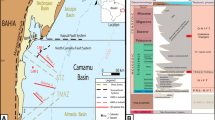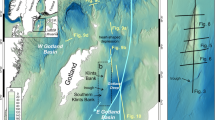Abstract
The Brazilian Continental Margin (BEM) deep-water regions contain important geological features, although the area is poorly explored beyond the continental shelf-break. The main objective of this study is to seismically characterize syn- and post-rift sequences and certain seamounts that are part of the Fernando de Noronha Ridge (FNR) in deep-water basins and are off of the shore of northeastern Brazil. We used 2D post-stack high-resolution seismic sections to distinguish syn-rift, post-rift, and drift tectono-depositional phases. Three seismic horizons (R1 to R3) could represent, respectively, the following: an acoustic basement top, a rift top, and a highstand system tract (drift). The syn-rift stage is marked by discontinuous parallel reflectors with low amplitude and low frequency, which are offset by normal faults in half-grabens. The post-rift and drift stages are characterized by continuous parallel reflectors with low to high amplitude and frequency. Chaotic seismic reflections within the seamounts indicate their volcanic origins. Volcanic intrusions affected syn-rift, post-rift, and drift sequences and partially confine the deep-water basin deposition. The magmatic event occurred once the preexistent material and the sediment deposited after the seamount rises were partially confined by the continental slope and the seamounts. Seismic stratigraphy interpretation and its correlation with volcanic activities indicate a relative chronological control relating the emplacement of the seamounts to the Early Eocene to Late Miocene. Volcanic episodes seem to have created volcanoclastic deposits marked by a disorganized/chaotic seismic pattern with few continuous reflectors, indicating interbedded magma flows with sedimentary material. This paper provides an initial observation regarding the deep-water basin deposits on syn- and post-rift stages in the NE portion of the BEM.





Similar content being viewed by others
References
Andrade JFP, Gomes MP, Bezerra FHR, de Castro DL, Vital H (2018) Morphotectonic development of the Ceará Terrace: a marginal ridge on the western side of the Romanche Fracture Zone in the Brazilian equatorial margin. Geo-Mar Lett 38:371–384. https://doi.org/10.1007/s00367-018-0541-y
Antobreh AA, Faleide JI, Tsikalas F, Planke S (2009) Rift-shear architecture and tectonic development of the Ghana margin deduced from multichannel seismic reflection and potential field data. Mar Pet Geol 26:345–368. https://doi.org/10.1016/j.marpetgeo.2008.04.005
Aquino da Silva AG, Stattegger K, Schwarzer K, Vital H (2016) Seismic stratigraphy as indicator of late Pleistocene and Holocene sea level changes on the NE Brazilian continental shelf. J S Am Earth Sci 70:188–197. https://doi.org/10.1016/j.jsames.2016.05.001
Barbosa GG (2013) Bacia Potiguar- 11a Rodada Brasil
Bell B, Butcher H (2002) On the emplacement of sill complexes: evidence from the Faroe-Shetland Basin. Geol Soc Spec Publ 197:307–329. https://doi.org/10.1144/GSL.SP.2002.197.01.12
Blarez E, Mascle J (1988) Shallow structures and evolution of the Ivory Coast and Ghana transform margin. Mar Pet Geol 5:54–64
Buarque BV, Barbosa A, Magalhães JRG, et al (2016) Post-rift volcanic structures of the Pernambuco Plateau, northeastern Brazil. J. S. Am. Earth Sci 70:251–267. https://doi.org/10.1016/j.jsames.2016.05.014
Buarque BV, Barbosa JA, Oliveira JTC (2017) Carbonate buildups in the Pernambuco Basin, NE Brazil. Acad Bras Ciênc 89:841–857
Catuneanu O (2006) Principles of Sequence Stratigraphy. Elsevier, Edmonton
(2007) Centro de Hidrografia da Marinha do Brasil (CHM). https://www.mar.mil.br/dhn/chm/box-cartas-nauticas/cartas.html. Accessed 6 May 2017
de Almeida NM, Vital H, Gomes MP (2015) Morphology of submarine canyons along the continental margin of the Potiguar Basin, NE Brazil. Mar Pet Geol 68:307–324. https://doi.org/10.1016/j.marpetgeo.2015.08.035
Araripe PT de, Feijó FJ (1994) Bacia Potiguar. In: Boletim de Geociencias da Petrobrás, 1st edn. Rio de Janeiro, pp 127–141
de Castro DL, Bezerra FHR, Sousa MOL, Fuck RA (2012) Influence of Neoproterozoic tectonic fabric on the origin of the Potiguar Basin , northeastern Brazil and its links with West Africa based on gravity and magnetic data. J Geodyn 54:29–42. https://doi.org/10.1016/j.jog.2011.09.002
Ding W, Li J, Dong C, Fang Y (2014) Oligocene – Miocene carbonates in the Reed Bank area , South China Sea , and their tectono-sedimentary evolution. Mar Geophys Res 36:149–165. https://doi.org/10.1007/s11001-014-9237-5
Gomes MP, Vital H, Bezerra FHR et al (2014) The interplay between structural inheritance and morphology in the Equatorial Continental Shelf of Brazil. Mar Geol 355:150–161. https://doi.org/10.1016/j.margeo.2014.06.002
Gorini M (1977) The tectonic fabric of the Equatorial Atlantic and adjoining continental margins: gulf of Guinea to northeastern Brazil. Columbia University
Hjelstuen BO, Andreassen EV (2015) North Atlantic Ocean deep-water processes and depositional environments: a study of the Cenozoic Norway Basin. Mar Pet Geol 59:429–441. https://doi.org/10.1016/j.marpetgeo.2014.09.011
Infante-Paez L, Marfurt KJ (2017) Seismic expression and geomorphology of igneous bodies . A Taranaki Basin , New Zealand case study. Interpretation 5:71. https://doi.org/10.1190/int-2016-0244.1
Jovane L, Figueiredo JJP, Alves DPV et al (2016) Seismostratigraphy of the Ceará Plateau: clues to decipher the Cenozoic evolution of Brazilian equatorial margin. Front Earth Sci 4:14. https://doi.org/10.3389/feart.2016.00090
Magee C, Maharaj SM, Wrona T, Jackson CA-L (2015) Controls on the expression of igneous intrusions in seismic reflection data. Geosphere 11:50
Mark NJ, Schofield N, Pugliese S et al (2018) Igneous intrusions in the Faroe Shetland basin and their implications for hydrocarbon exploration; new insights from well and seismic data. Mar Pet Geol 92:733–753. https://doi.org/10.1016/j.marpetgeo.2017.12.005
Matos RMD (1992) The northeast Brazilian rift system. Tectonics 11:766–791
Matos RMD (1999) History of the northeast Brazilian rift system: kinematic implications for the break-up between Brazil and West Africa. Geological Society, London, Special Publications 153 (1):55–73. https://doi.org/10.1144/GSL.SP.1999.153.01.04
Matos RMD (2000) Tectonic Evolution of the Equatorial South Atlantic The Brazilian and West African Equatorial margins comprise America. In: Atlantic Rifts and Continental Margins. American Geophysical Union, Natal-RN-Brazil, pp 331–354
Milani EJ, Brandão JASL, Zalán PV, Gamboa LAP (2000) Petróleo na margem continental Brasileira: Geologia, exploração, resultados e perspectivas. Rev Bras Geof 18:351–396. https://doi.org/10.1590/690S0102-261X2000000300012
Mitchum Jr RM, Vail PR, Sangree JB (1977) Seismic stratigraphy and global patterns in depositional sequences In: Payton, C. E. (ed). Seismic Stratigraphy – Applications to Hidrocarbon Exploration. Tulsa, AAPG, 117-133 (Memoir 26). In: Payton CE (ed) Memoir 26. AAGP, Tulsa, pp 117–133
Mizusaki AMP, Thomaz Filho A, Milani EJ, Césero P (2002) Mesozoic and Cenozoic igneous activity and its tectonics control in northeastern Brazil. J S Am Earth Sci 15:183–198
National Oceanic and Atmospheric Administration (2018) NOAA. https://www.noaa.gov/
Perlingeiro G, Vasconcelos PM, Knesel KM et al (2013) 40Ar/39Ar geochronology of the Fernando de Noronha Archipelago and implications for the origin of alkaline volcanism in the NE Brazil. J Volcanol Geotherm Res 249:140–154. https://doi.org/10.1016/j.jvolgeores.2012.08.017
Pessoa Neto O da C (1999) Análise Estratigráfica Integrada da Plataforma Mista (Siliciclástica-Carbonática) do Neogeno da Bacia Portiguar, Nordeste do Brasil. 220
Pessoa Neto O d C (2003) Estratigrafia de Sequências da plataforma 711 mista neogênica na Bacia Potiguar, Margem Equatorial Brasileira. 712 Rev Bras Geociênc 33:263–278
Pessoa Neto O d C, Soares UM, Fernandes Da Silva JG et al (2007) Bacia 714 Potiguar. Boletim de Geociencias da Petrobras 15:357–369
Pushcharovskii YM (2004) Deep-sea basins of the Atlantic Ocean: the structure, time and mechanisms of their formation. Russ J Earth Sci 6:133–152. https://doi.org/10.2205/2004ES000146
Rivalenti G, Mazzucchelli M, Girardi V a V et al (2000) Composition and processes of the mantle lithosphere in northeastern Brazil and Fernando de Noronha: evidence from mantle xenoliths. Contrib Mineral Petrol 138:308–325. https://doi.org/10.1007/s004100050565
Scarselli N, Mcclay K, Elders C (2016) Seismic geomorphology of Cretaceous megaslides offshore Namibia (Orange Basin): insights into segmentation and degradation of gravity-driven linked systems. Mar Pet Geol. https://doi.org/10.1016/j.marpetgeo.2016.03.012
Schofield N, Holford S, Millett J et al (2015) Regional magma plumbing and emplacement mechanisms of the Faroe-Shetland Sill Complex: implications for magma transport and petroleum systems within sedimentary basins. Basin Res 29:41–63. https://doi.org/10.1111/bre.12164
Smallwood JR, Maresh J (2002) The properties, morphology and distribution of igneous sills: modelling, borehole data and 3D seismic from the Faroe-Shetland area. In: Jollley DW, Bell BR (eds) The North Atlantic Igneous Province: Stratigraphy, Tectonic, Volcanic and Magmatic Processes. Geological Society, London, Special Publications, London, pp 271–306
Tcherepanov EN, Droxler AW, Lapointe P, Mohn K (2008) Carbonate seismic stratigraphy of the Gulf of Papua mixed depositional system : Neogene stratigraphic signature and eustatic control. Basin Res 185–209. doi: https://doi.org/10.1111/j.1365-2117.2008.00364.x
Vail PR, Mitchum RM Jr (1977) Seismic stratigraphy and global changes of sea level: Part 1: Overview. In: Payton C (ed) Memoir 26. AAGP, Tulsa, pp 51–52
Veeken PCH (2007) Seismic stratigraphy, basin analysis, and reservoir characterization. Elsevier Ltd, Oxford
Viana A, Júnior S, Batista J et al (2008) Evolução Da Margem Atlântica Equatorial Do Brasil : Três Fases Distensivas. Geociências 3:427–437
Vital H (2014) Chapter 4 The north and northeast Brazilian tropical shelves. Geol Soc Lond Mem 41:35–46. https://doi.org/10.1144/M41.4
Vital H, State N, Stattegger K et al (2008) A modern high-energy 753 siliciclastic-carbonate platform: continental shelf adjacent to 754 Northern Rio Grande do Norte state, Northeastern Brazil. In: Recent Advances in Models of Siliciclastic Shallow-marine Stratigraphy. Society for Sedimentary Geology (SEPM), Special Publication 90,175–188
Vital H, Gomes MP, Tabosa WF et al (2010) Characterization of the Brazilian continental shelf adjacent to Rio Grande do Norte State, Ne Brazil. Braz J Oceanogr 58:43–54. https://doi.org/10.1590/S1679-87592010000500005
Wilson JT (1963) A possible origin of the Hawaiian Islands. Can J Phys 41:863–870
Wilson JT (1965) A new class of faults and their bearing on continental drift. Nature 207:343–347. https://doi.org/10.1038/207343a0
Acknowledgments
The authors thank the Brazilian Council and Coordination for the Improvement of Higher Education Personnel (CAPES) and National Council for Scientific and Technological Development (CNPq) for their grants. We also thank the National Agency of Petroleum, Natural Gas and Biofuels (ANP) for the seismic dataset, the Federal University of Rio Grande do Norte (PPGG/UFRN) for the infrastructure required for the data interpretation, and Schlumberger for the Petrel E&P Software Platform license. We are also grateful to David Iacopini for his constructive comments and to an anonymous reviewer and the editor of this journal for their help in improving the quality of the original manuscript.
Funding
This is a contribution to Project Geohazards and Tectonics (CAPES – IODP grant 88887.123925/2015-00).
Author information
Authors and Affiliations
Corresponding author
Additional information
Publisher’s note
Springer Nature remains neutral with regard to jurisdictional claims in published maps and institutional affiliations.
Rights and permissions
About this article
Cite this article
Fonseca, J.C.L.G., Vital, H., Perez, Y.A.R. et al. Seismic stratigraphy of a deep water basin in the Brazilian equatorial margin: the eastern portion of Potiguar Basin and Touros High. Geo-Mar Lett 40, 977–988 (2020). https://doi.org/10.1007/s00367-019-00626-7
Received:
Accepted:
Published:
Issue Date:
DOI: https://doi.org/10.1007/s00367-019-00626-7




